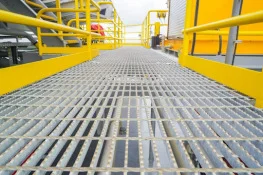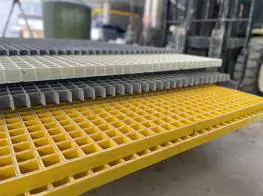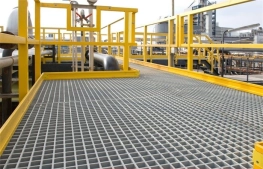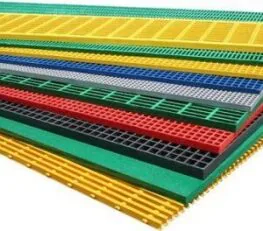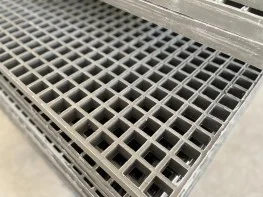Top 10 Advantages of FRP Composite Grating Panels: Corrosion-Resistant, Durable, and Lightweight.
Nowadays, FRP composite grating floor panels are gradually becoming the top choice in industrial, civil construction, and infrastructure projects due to their outstanding advantages in durability, lightweight, corrosion resistance, and versatility. With the development of new materials, this floor panel not only effectively replaces traditional steel grating but also opens up the trend of using composite materials in various fields requiring high technical standards.
Overview of FRP Composite Grating Floor Panels
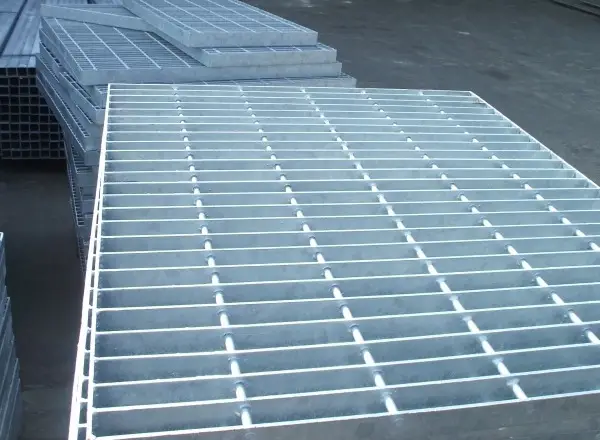
FRP composite grating floor panels provide an ideal replacement for metal floors, which are prone to corrosion and degradation under various environmental conditions. Before delving into the advantages and applications of this product, let’s explore the structure, basic properties, and why more and more companies are choosing it for their projects.
Structure and Composition of FRP Composite Grating Floor Panels

FRP composite grating floor panels are primarily composed of fiberglass combined with high-quality polyester or vinylester resin through a modern molding process.
Fiberglass acts as a reinforcement, increasing the load-bearing capacity and enhancing the mechanical stability of the product. Meanwhile, the composite resin base helps protect the fiberglass from environmental factors, providing water resistance, chemical resistance, and UV resistance.
This combination allows the floor panels to be significantly lighter than steel, while still offering high durability, good elasticity, and a long service life.
Additionally, depending on the application requirements, FRP composite grating floor panels can be designed with mesh holes to allow water drainage, reduce weight, or increase slip resistance by adding a textured surface coating.
Outstanding Advantages Compared to Traditional Gratings

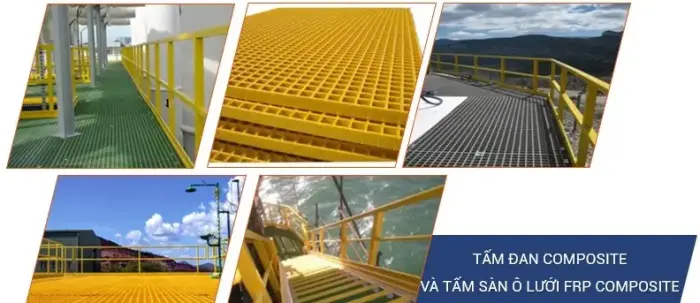
One of the biggest advantages of FRP composite grating floor panels is their nearly absolute corrosion resistance in acidic, alkaline, seawater, or chemical solvent environments.
Meanwhile, steel gratings, even when galvanized or coated, still face rusting over time, especially when continuously exposed to wet environments or chemicals. This increases maintenance costs, replacement, and structural safety concerns.
Furthermore, with a weight only about 1/3 to 1/4 of steel, the transportation and installation of FRP composite grating floor panels become much easier, saving labor costs and installation time.
In particular, composite materials also have electrical insulating properties and low thermal conductivity, ensuring safety in explosive or high-voltage environments.
Reasons to Choose FRP Composite Grating Floor Panels
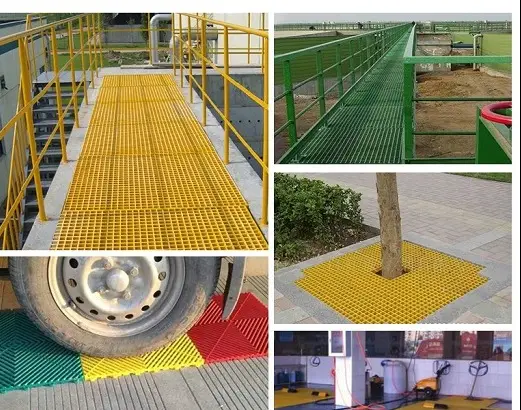
FRP composite grating floor panels can be said to fully meet the criteria of “durable – lightweight – safe – cost-effective,” making them an optimal flooring solution for modern projects.
Eliminating the hassles caused by rust helps businesses significantly reduce long-term maintenance costs while maintaining the initial appearance and safety for users.
The product also contributes to improving labor productivity, reducing stress on the overall structural load of the project due to its lightweight, thus opening up more creative and flexible design options compared to traditional materials.
Outstanding Advantages of FRP Composite Grating Floor Panels

FRP composite grating floor panels are not just a replacement for steel floors, but also have many outstanding advantages that make them the ideal choice in a variety of practical applications. Below is a detailed analysis of the most prominent advantages of this new material.
Mechanical Durability and Long Service Life
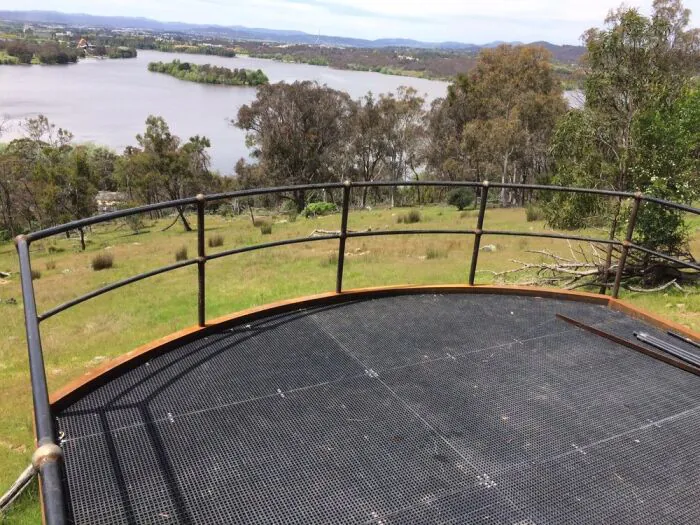
The load-bearing capacity of FRP composite grating floor panels is impressive due to the fiberglass structure embedded in the resin base.
The product can withstand loads equivalent to or even exceeding those of traditional steel floors, but still retains its lightweight, reducing the load on the overall structure of the project.
Moreover, composite materials are less affected by weather factors such as temperature, humidity, or UV radiation, helping maintain mechanical durability after many years of outdoor use or in harsh environments.
According to practical studies, the average lifespan of FRP composite grating floor panels can reach 30-50 years without the need for coatings or complicated maintenance, far surpassing traditional metal gratings.
Therefore, investing in this type of floor panel provides long-term economic efficiency, minimizing repair and replacement costs throughout its service life.
Excellent Corrosion Resistance and Chemical Resistance
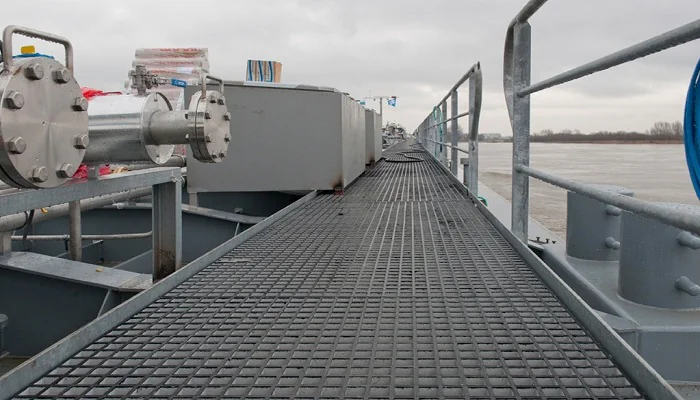
One of the standout strengths of FRP composite grating floor panels is their almost absolute corrosion resistance in harsh working conditions.
Composite materials can withstand the impact of seawater, acids, alkalis, oils, and organic solvents without losing their mechanical properties or surface deforming.
This makes them the ideal choice for chemical plants, oil refineries, food processing plants, wastewater treatment systems, or coastal projects, and oil rigs.
Thanks to their excellent chemical resistance, the floor panels are also less prone to rotting and do not require frequent protective coatings, thus significantly reducing the overall system operation costs.
In addition, FRP composite materials are non-magnetic, making them suitable for environments that require strict electromagnetic field control, such as laboratories and radar stations.
Lightweight, Easy to Install and Maintain

Weighing only about 1/3 of steel, FRP composite grating floor panels are very convenient for transportation, installation, and removal.
Installation does not require specialized lifting equipment, reducing labor costs and accelerating construction progress.
Additionally, with their modular design, it’s easy to replace individual panels when damage occurs without dismantling the entire floor system.
The composite surface helps prevent dust buildup and is easy to clean or wash, meeting the strict hygiene requirements of the food, medical, or clean industries.
The material's stability also helps reduce shrinkage or thermal expansion, minimizing cracks and warping over long-term use.
Human Safety and Environmental Friendliness
Another advantage of FRP composite grating floor panels is their electrical insulation, which ensures safety for workers in explosive environments or areas with high electrical requirements.
Furthermore, FRP composite materials have a high melting point, excellent fire resistance, and some types are added with additives to self-extinguish when burning, enhancing fire safety.
The manufacturing process of this material also generates minimal hazardous waste, and it can be easily recycled or disposed of after its service life, helping reduce negative environmental impact.
The material contains no heavy metals or dangerous compounds, does not pollute water or air in normal usage conditions, and meets international safety standards and the trend of sustainable development.
Common Applications of FRP Composite Grating Floor Panels in Practice
Thanks to its many outstanding advantages, FRP composite grating floor panels are increasingly being applied in many industries and fields. They not only effectively replace metal floor panels but also expand the range of applications due to their superior features.

Chemical, Oil & Gas, and Water Treatment Industries
In chemical plants, oil refineries, and wastewater treatment systems, working conditions are very harsh with environments frequently exposed to corrosive chemicals and hazardous solvents.
Using FRP composite grating floor panels helps ensure the longevity and safety of the working floor systems, technical walkways, and equipment supports.
The product is not corroded by acids, alkalis, seawater, or organic solvents, ensuring stable operation and reducing maintenance costs.
Moreover, the electrical insulation and non-flammability of the material enhance labor safety in areas prone to fire or electrical leaks.
In particular, the lightweight nature helps reduce the load on offshore drilling platforms, where weight plays a critical role in design and operation.
Food, Pharmaceutical, and Clean Industries
In food and pharmaceutical manufacturing plants, hygiene and contamination control are extremely strict.
FRP composite grating floor panels, with their smooth surface, minimal dust accumulation, easy cleaning, and resistance to oxidation or rusting, are the ideal choice.
Its excellent corrosion resistance helps prevent degradation by strong cleaning or sterilizing solutions, extending the product's service life and reducing replacement frequency.
Moreover, composite materials contain no heavy metals or harmful chemicals, ensuring absolute safety for the processing and packaging of products.
A clean production environment, free from rust dust, also improves product quality and meets food safety hygiene standards.
Transportation Infrastructure, Civil, and Public Systems
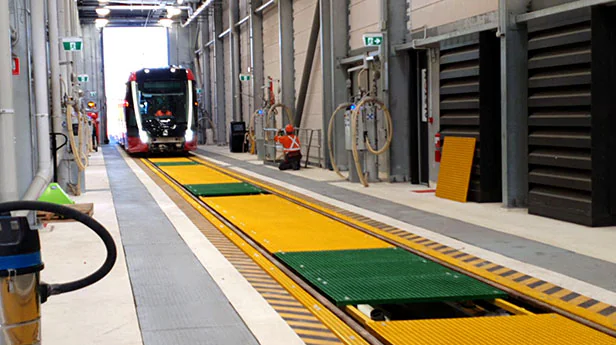
Not limited to the industrial sector, FRP composite grating floor panels are also widely used in civil construction and urban infrastructure projects.
Pedestrian bridges, elevated technical corridors, handrails, emergency stairways, and more can all utilize this material to reduce the structure’s weight while ensuring durability.
The corrosion resistance helps the floors remain color-fast and rust-free even when installed outdoors, near the coast, or in humid climates.
The anti-slip surface and easy-to-clean features enhance safety and reduce slip accidents in public areas.
Additionally, the high aesthetic appeal, diverse colors, and ease of shaping make FRP composite grating floor panels an excellent material for both interior and exterior decoration.
Specific Applications: Shipbuilding, Electronics, and Special Projects
In the shipbuilding industry, FRP composite grating floor panels are widely used on ship decks, outdoor work floors, and storage tanks due to their effectiveness in resisting seawater and corrosion.
The electronics industry takes advantage of its electrical insulation and non-magnetic properties to install it in laboratories, factories producing sensitive electronic components.
Other specific applications include escape systems, military construction, radar stations, airports, and transformer stations... which prioritize FRP composite for its outstanding features.
It is clear that the range of applications for this material is expanding, contributing to improved quality, safety, and reduced operational costs across various industries.
Considerations When Choosing and Installing FRP Composite Grating Floor Panels

Despite its many advantages, to maximize its effectiveness, businesses need to pay attention to several technical factors when selecting, designing, and installing FRP composite grating floor panels.
Determine the Correct Load and Dimensions
The first important factor when choosing floor panels is to determine the exact load that the floor needs to bear, including static and dynamic loads.
Based on these parameters, the supplier will advise on the appropriate fiberglass type, mesh density, thickness, and weave style.
Correct selection ensures operational safety and avoids wasting resources by using floors that exceed the actual needs.
Additionally, the panel dimensions, shape (square, rectangular, round), and edge style should be designed to fit the installation space and intended use.
It is also important to ensure that the joints and seams are accurate to ensure a tight connection, avoiding subsidence or vibration during installation and long-term use.
Choose the Correct Resin Type and Surface Style for the Environment
Next, choosing the correct resin type in the composite is crucial.
If the working environment is highly acidic or alkaline, vinylester resin should be prioritized over standard polyester to increase chemical resistance.
If high heat resistance or fire risk is required, fire-retardant resins with additives should be selected to meet fire safety standards.
For the surface, depending on the anti-slip or ease of cleaning requirements, textured, serrated, or glossy resin coatings can be chosen for aesthetic enhancement.
Proper selection will enhance product longevity and ensure maximum safety for users in real-world conditions.
Ensure Proper Training for Installation and Maintenance
Another important note is that the installation team needs to be properly trained in handling composite materials to ensure installation quality.
Techniques like cutting, drilling, and bolting should use specialized tools to avoid damaging the reinforcement layer inside.
When fixing the panels to steel or concrete frames, compatible accessories should be used to avoid cracking at the anchor points.
Additionally, panels should not be moved or dropped from high places to ensure no internal structural damage, maintaining durability and safety during use.
Following proper installation procedures will help maximize performance and minimize risks during future maintenance and operation.
Regular Maintenance and Cleaning to Maintain Durability
Although FRP composite grating floor panels have high durability and are resistant to corrosion, regular cleaning and maintenance are still essential to ensure long-term effectiveness.
Regularly inspect joints and fixings to detect any damage, cracks, or wear.
Surface cleaning can be done easily with clean water, soap, or mild cleaning solutions, avoiding strong chemicals that may degrade the resin base's properties.
If cracks are detected, contact the supplier for advice on suitable repair or replacement solutions to ensure safety in future use.
Frequently Asked Questions about FRP Composite Grating Floor Panels
Can FRP Composite Grating Floor Panels completely replace steel gratings?
Absolutely. With its many advantages in corrosion resistance, lightweight, electrical insulation, and high mechanical durability, FRP composite grating floor panels are gradually replacing steel gratings in many applications, especially in chemical environments, coastal areas, or those requiring electrical insulation.
What is the average lifespan of FRP composite grating floor panels?
The average lifespan of this type of floor panel can reach 30-50 years, depending on environmental conditions and usage intensity. This significantly surpasses the lifespan of traditional steel floors.
Do FRP composite grating floor panels require regular maintenance?
No complex maintenance is required, just periodic cleaning and inspection of joints. If damage is detected, repairs or replacements should be made, saving much on maintenance costs compared to steel.
Can FRP composite grating floor panels be used outdoors?
They are highly suitable. Thanks to their UV resistance, corrosion resistance, and weather durability, they are ideal for use in pedestrian overpasses, outdoor walkways, handrails, and ship decks without worrying about rusting or fading.
Is the price of FRP composite grating floor panels higher than steel?
The initial price may be slightly higher than steel, but considering the total lifecycle cost (long lifespan, low maintenance, easy installation), using FRP composite grating floor panels will save significantly in the long run.
https://xaydunghoabinh.com.vn/san-pham/san-grating-composite
Conclusion
In the trend of sustainable development and improving construction quality, FRP composite grating floor panels stand out as the optimal choice due to their outstanding advantages: durability, lightweight, corrosion resistance, electrical insulation, safety, and versatility in applications.
Investing in this advanced material not only improves operational efficiency, reduces maintenance costs but also contributes to environmental safety and worker health. We hope this article helps you gain a comprehensive understanding to choose the most suitable flooring solution for your project.
IV. Contact
-
https://www.youtube.com/@Nap-ho-ga-song-thu-rac-Grating
-
Hotline: 0936629323



